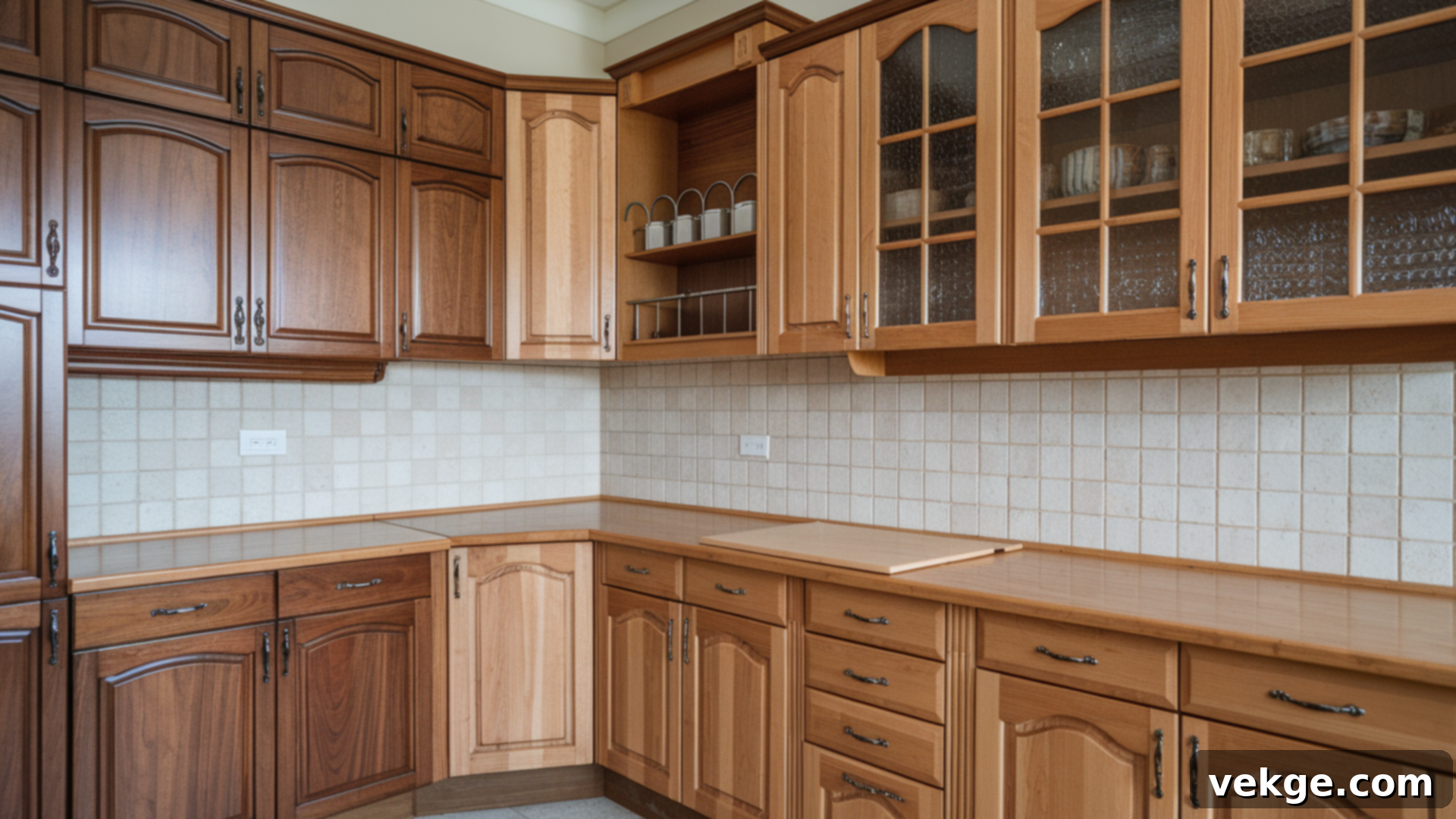Select the Perfect Wood: Your Comprehensive Guide to Kitchen Cabinet Materials
Choosing the ideal wood for your kitchen cabinets is a pivotal decision that significantly influences both the aesthetic appeal and the long-term durability of your kitchen space. With an abundance of wood species and cabinet materials available, navigating the options to find the perfect fit can feel overwhelming.
Are you searching for a material robust enough to withstand the rigors of a busy family kitchen, or are you prioritizing a specific color tone or distinctive grain pattern to flawlessly complement your interior design vision? This in-depth guide is crafted to simplify your decision-making process. We will explore the top wood choices for kitchen cabinets, providing a balanced look at the advantages and disadvantages of each. Furthermore, we’ll delve into critical factors such as inherent durability, overall cost, and the required maintenance, empowering you to make a truly informed choice that aligns with your lifestyle and budget. Let’s embark on this journey to discover the ultimate wood for your dream kitchen cabinets.
Key Considerations When Choosing Wood for Kitchen Cabinets
Before diving into specific wood species, it’s crucial to understand the fundamental attributes that define a good wood for kitchen cabinets. Keeping these key factors in mind will help you narrow down your choices and ensure satisfaction for years to come:
- Durability and Hardness: Kitchen cabinets endure daily wear and tear, from opening and closing to accidental bumps and spills. Therefore, durability is paramount. Hardwoods, such as maple, oak, and cherry, are highly favored for their exceptional strength, resistance to dents and scratches, and impressive longevity. The harder the wood, the better it typically stands up to everyday use in a high-traffic area like the kitchen.
- Aesthetics: Color and Grain Pattern: The visual characteristics of the wood — its natural color, unique grain patterns, and how it responds to finishes — will largely dictate your kitchen’s overall style and ambiance. Some woods offer a smooth, uniform appearance, while others boast prominent, distinctive grains. Consider how these natural features will harmonize with your chosen kitchen design, be it modern, traditional, rustic, or transitional.
- Cost-Effectiveness: Your budget will inevitably play a significant role in your material selection. Premium hardwoods like walnut and cherry are generally at the higher end of the price spectrum, reflecting their beauty and rarity. Conversely, more common or softer woods such as pine and poplar offer more budget-friendly alternatives without necessarily compromising on style or functionality when properly finished.
- Maintenance and Care Requirements: Different wood types require varying levels of maintenance to preserve their beauty and integrity. For instance, some woods like cherry and walnut may necessitate more diligent care and specific cleaning products to maintain their rich finish and prevent fading, while oak is generally more forgiving and simpler to maintain. Understanding the long-term care commitment is essential for a sustainable choice.
- Environmental Impact and Sustainability: For eco-conscious homeowners, the environmental footprint of their chosen wood is an important consideration. Opting for wood sourced from sustainably managed forests, often certified by organizations like the Forest Stewardship Council (FSC), ensures that your cabinets contribute to responsible forestry practices. Many reputable manufacturers now offer FSC-certified options, guaranteeing that the wood was harvested ethically.
Top Wood Choices for Kitchen Cabinets
When selecting the best wood for your cabinets, the goal is to find a perfect balance between stunning aesthetics and robust durability. Here’s a detailed look at some of the most popular and reliable wood choices for your kitchen renovation:
1. Maple: The Versatile and Resilient Choice
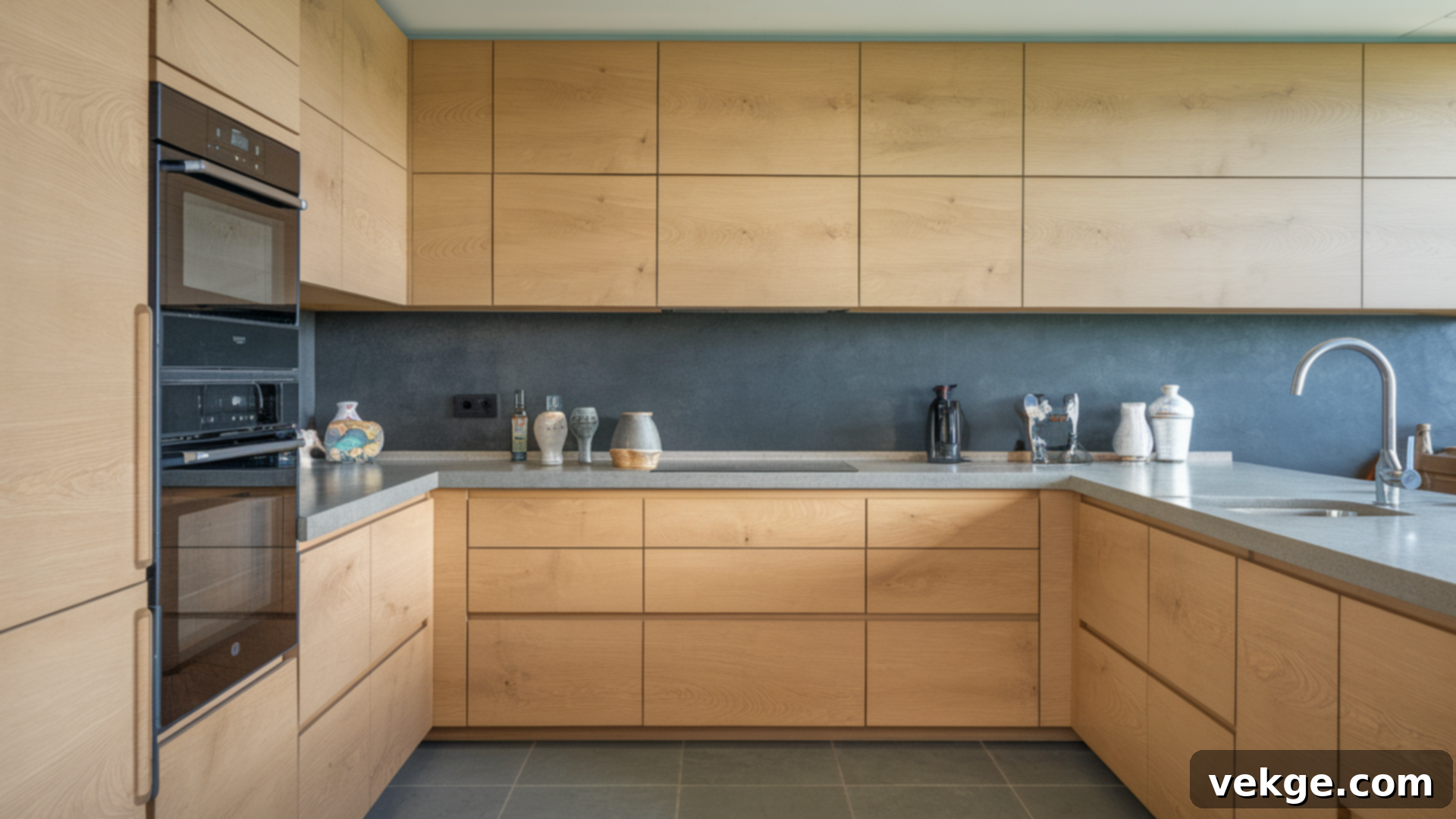
Maple stands out as an exceptionally popular choice for kitchen cabinets, widely appreciated for its combination of affordability and remarkable durability. Characterized by its fine, even grain and subtle texture, maple wood offers a naturally light, creamy hue that can brighten any kitchen. Its understated beauty makes it incredibly versatile, seamlessly complementing both cutting-edge modern and timeless traditional kitchen designs.
As a hardwood, maple boasts impressive resistance to dings, scratches, and everyday impacts, making it an ideal candidate for high-traffic areas like the kitchen. Furthermore, maple’s smooth surface is excellent for accepting a variety of finishes. It takes stains evenly, resulting in a consistent color, and is particularly prized for its ability to create a flawless, uniform finish when painted. This versatility ensures that maple cabinets can easily adapt if you decide to update your kitchen’s style in the future. Maple typically costs between $5 to $8 per square foot, offering excellent value for its quality and aesthetic appeal.
2. Cherry: Classic Elegance with a Rich, Developing Patina
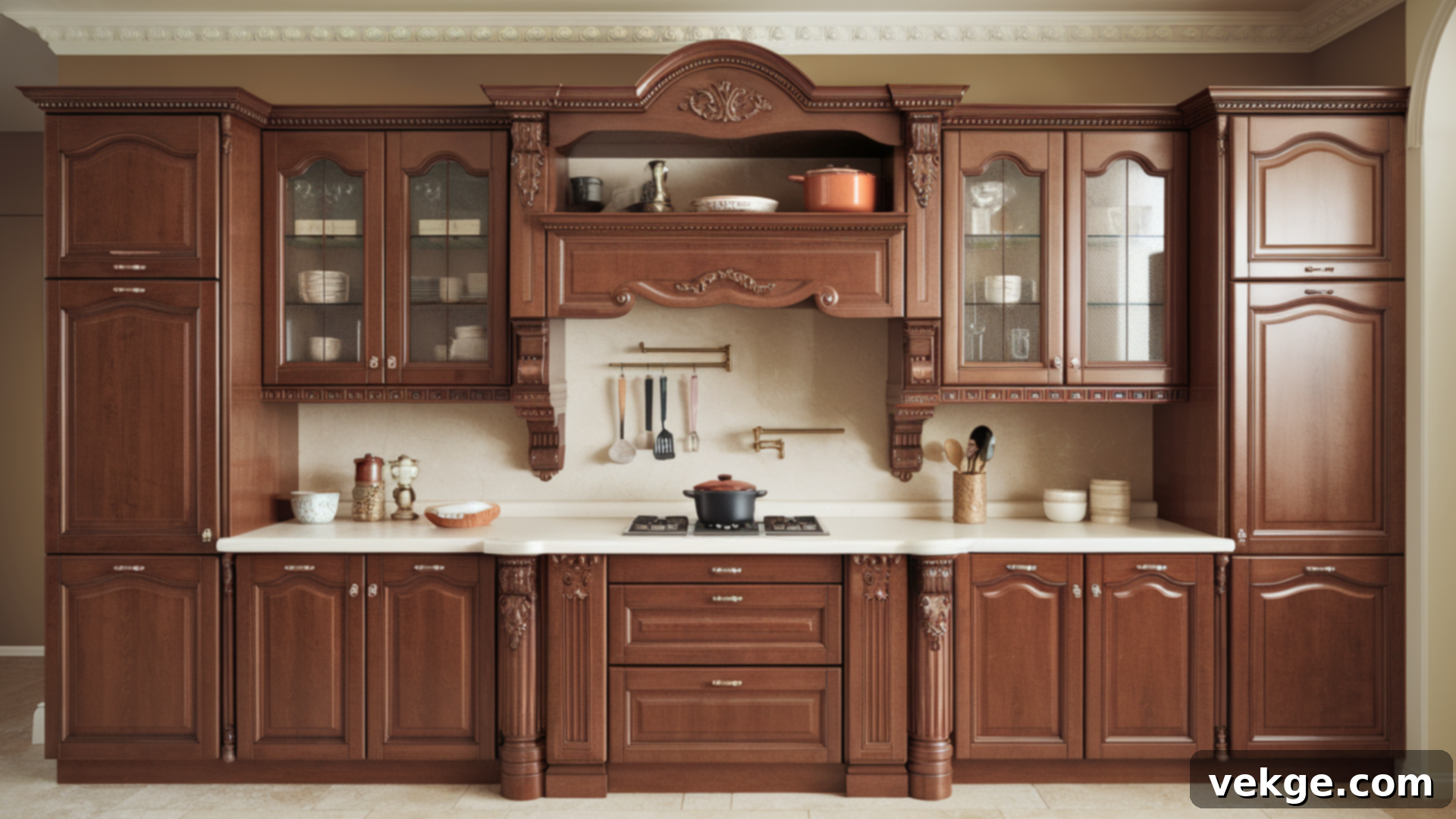
Cherry wood is celebrated for its distinctive rich, reddish-brown hue that matures beautifully over time, developing a deeper, more lustrous patina with exposure to light and age. This graceful aging process adds character and warmth, making cherry a highly sought-after material for those desiring a kitchen with enduring charm and sophistication. Its fine, uniform grain patterns create a smooth, elegant surface that enhances its luxurious appeal.
As a durable hardwood, cherry offers substantial strength and resilience, making it a reliable choice for long-lasting cabinets. It presents a naturally beautiful appearance, perfect for both traditional, classic, and even some contemporary kitchen aesthetics. However, cherry typically falls into a higher price bracket compared to maple or oak, reflecting its premium quality and unique aging properties. It also requires a bit more thoughtful maintenance to preserve its exquisite finish, guarding against direct sunlight which can accelerate its darkening process unevenly. For homeowners who appreciate a luxurious look and are prepared to invest a little extra effort in upkeep, cherry is an unparalleled choice. Expect cherry to cost around $8 to $12 per square foot.
3. Oak: The Enduring and Characterful Option
Oak has long been a foundational material in kitchen cabinetry, revered for its exceptional strength and timeless appeal. It is easily recognized by its distinctive, open grain pattern, which can range from straight and subtle to bold and swirling, and its warm, inviting tones. This inherent character makes oak an outstanding choice for kitchens embracing rustic, traditional, or farmhouse design styles, adding a sense of natural charm and authenticity.
As one of the hardest and most durable hardwoods available, oak cabinets are incredibly resilient, capable of withstanding the daily impacts and demands of a busy kitchen environment without showing significant wear. Its robust nature and relatively affordable price point, especially when considering its longevity, make it a popular and practical option for many homeowners. Oak is also remarkably easy to maintain, requiring minimal effort to keep it looking its best. With an average cost of $6 to $10 per square foot, oak offers a fantastic balance of durability, classic beauty, and value, cementing its status as a staple in home design.
4. Walnut: Unrivaled Premium Sophistication
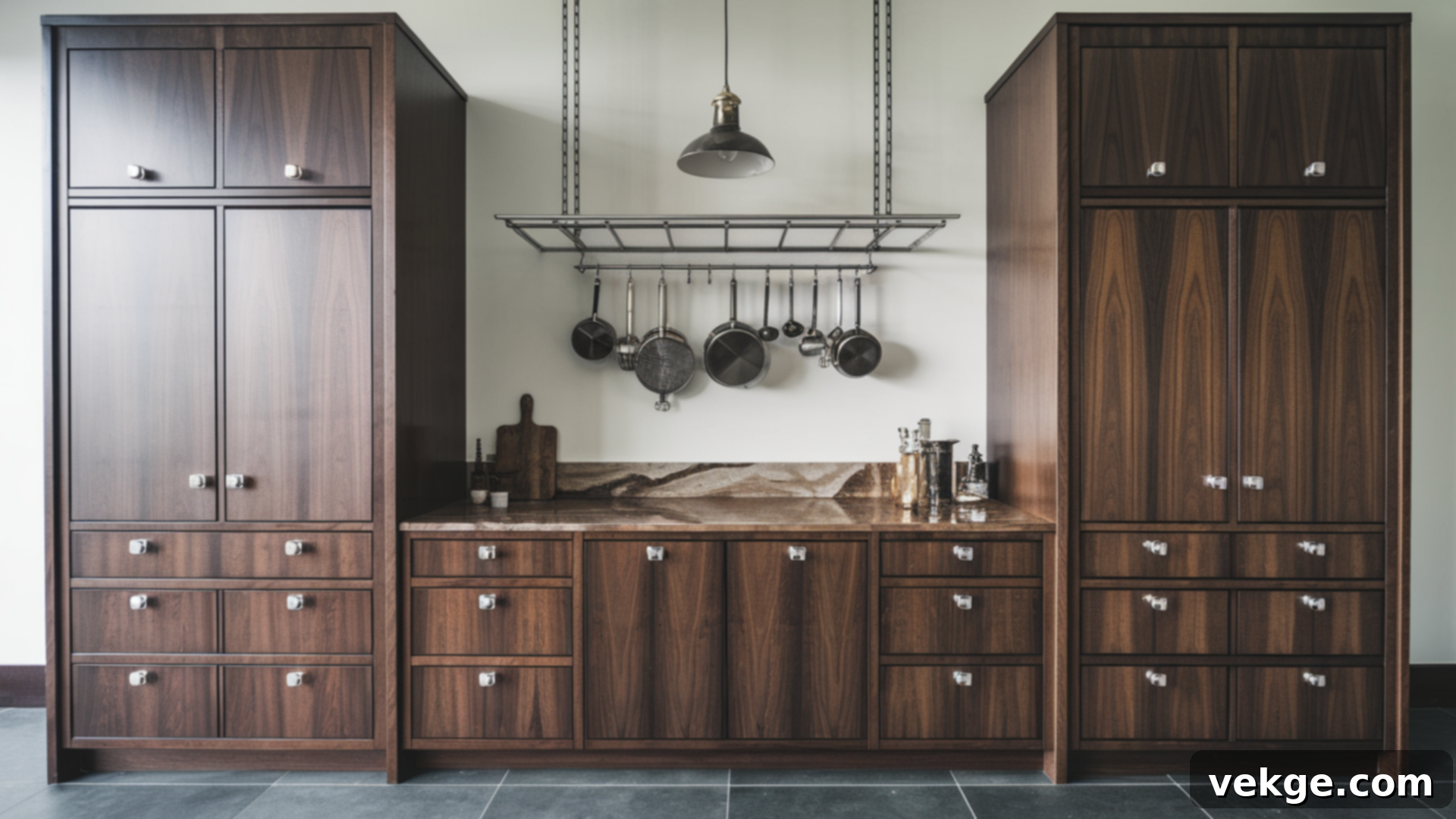
Walnut is truly a premium wood that exudes an unparalleled sense of luxury and refinement, instantly elevating the aesthetic of any kitchen. Its most striking features are its naturally deep, rich chocolate-brown color, often with purple or gray undertones, and its beautifully intricate grain patterns. These characteristics combine to create an eye-catching, sophisticated look for cabinet doors and drawers that few other woods can match.
Beyond its stunning appearance, walnut is a robust hardwood known for its excellent durability and resistance to wear and tear. While it is undeniably more expensive than common hardwoods like maple or oak, its investment is justified by its high-end, sophisticated appeal and enduring quality. Walnut is best suited for homeowners looking to make a bold statement and achieve a truly distinctive kitchen design, from sleek modern to elegantly traditional. To maintain its natural beauty and lustrous finish, walnut does require regular, gentle maintenance. Walnut typically ranges from $12 to $15 per square foot, positioning it as a top-tier choice.
5. Birch: A Smart, Budget-Friendly Hardwood Alternative
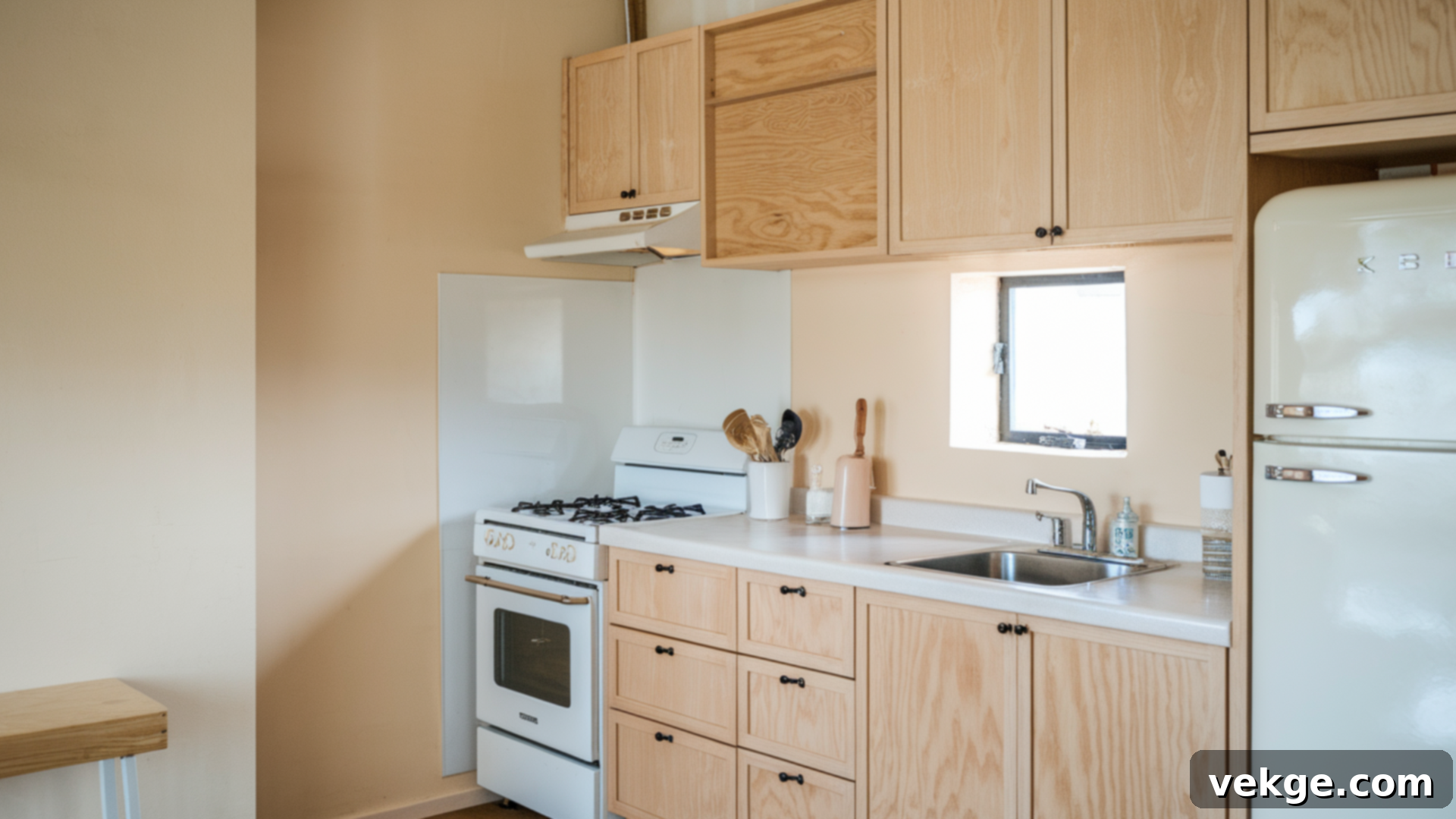
Birch is a versatile hardwood that presents an attractive proposition for those seeking the durability of hardwood at a more accessible price point. It is characterized by its pale, often creamy-white color and a smooth, fine, and relatively uniform grain. This subtle appearance makes birch an excellent canvas for various finishes, especially paint, where it creates a clean and contemporary look.
While not as hard as maple or oak, birch still offers good durability for kitchen cabinet applications, proving resilient enough for daily use. It’s an ideal choice if you’re working with a strict budget but refuse to compromise on the benefits of hardwood construction. Its light color and smooth texture make it particularly suitable for achieving a bright, airy feel in a kitchen, fitting well into modern, minimalist, or even Scandinavian design themes. Birch generally costs between $5 to $9 per square foot, making it a compelling option for value-conscious homeowners.
6. Poplar: The Economical and Highly Paintable Wood
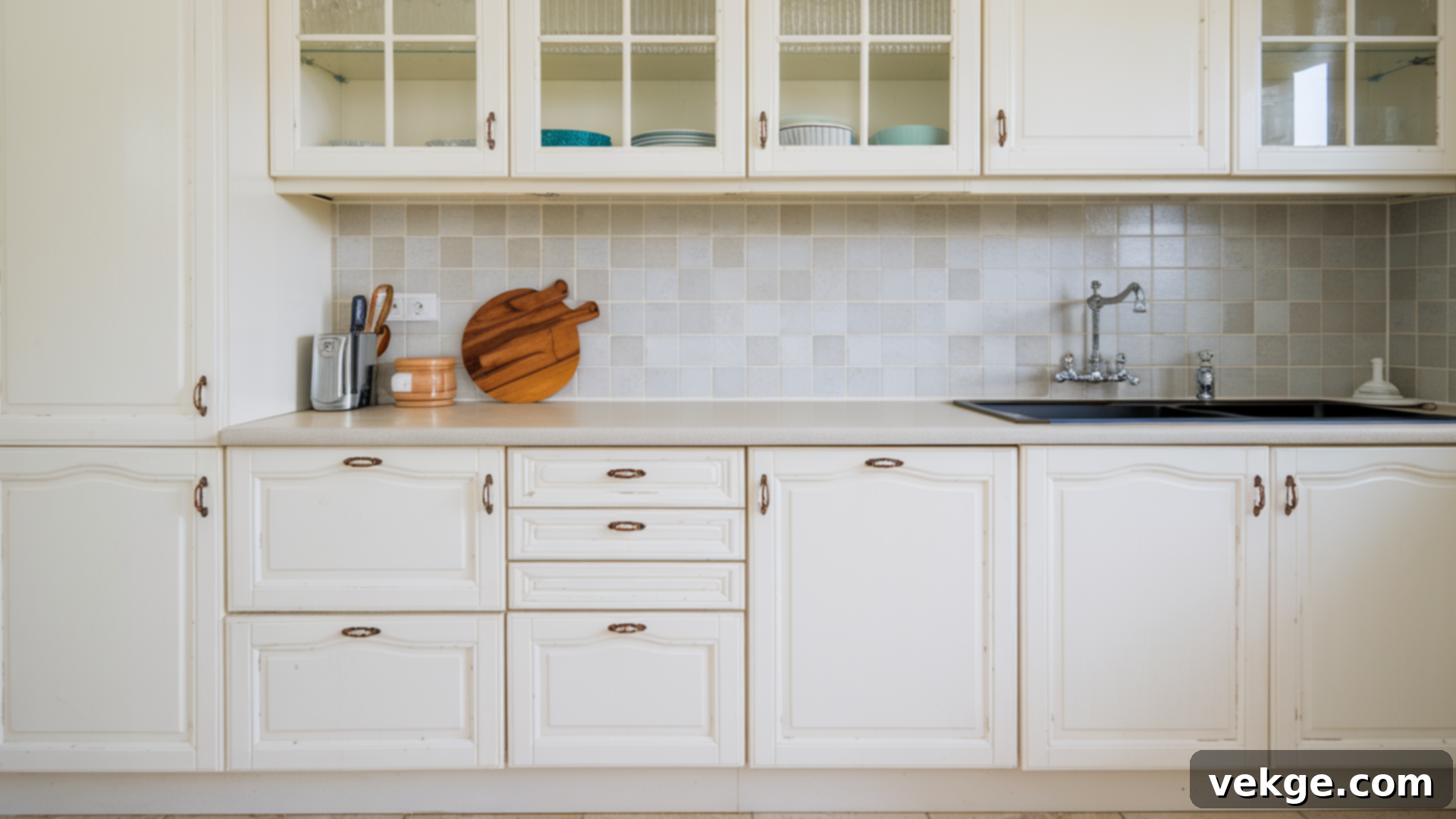
Though technically classified as a hardwood, poplar is notably softer than other popular hardwoods like maple or oak, which contributes to its affordability. This characteristic makes it an excellent, budget-friendly option for kitchen cabinets, particularly when the primary goal is to achieve a painted finish. Poplar has a relatively straight, even grain and a pale, often greenish hue that becomes nearly invisible once painted.
While its softness means it’s more susceptible to dents and scratches than harder woods, poplar excels as a substrate for paint. Its smooth, uniform surface takes paint beautifully, resulting in a crisp, clean finish without the prominent grain patterns that can show through on other woods. This makes it an ideal choice for homeowners who envision vibrant or specific color schemes for their kitchens and prefer a painted cabinet look over natural wood finishes. Poplar typically costs between $4 to $6 per square foot, offering significant savings for painted cabinetry projects.
7. Pine: Light, Rustic, and Budget-Friendly
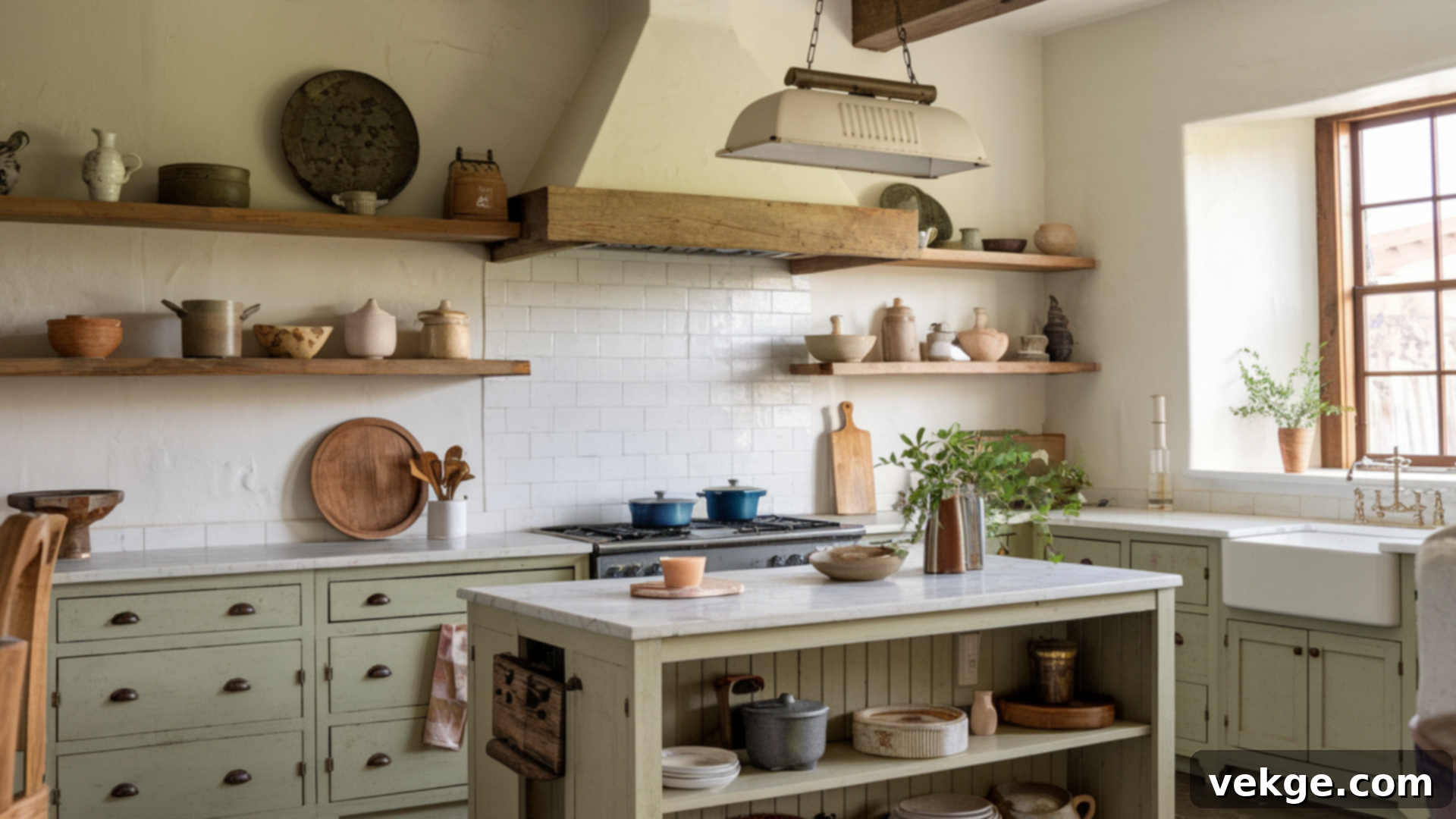
Pine is a softwood prized for its ease of workability, light appearance, and exceptional affordability. It typically features a straight grain pattern and a distinctive presence of knots, which contribute to its rustic and natural charm. While pine does not possess the same level of hardness or durability as hardwoods like oak or maple, it can still create a truly beautiful and characterful addition to a kitchen, particularly well-suited for rustic, farmhouse, or country-style aesthetics.
Its lighter color can make a kitchen feel more open and inviting. Pine’s unique characteristics, including its prominent knots and softer nature, mean it will show dings and dents more readily, which some homeowners appreciate as part of its lived-in, antique appeal. Pine is an excellent choice for those on a tight budget or homeowners seeking a lighter wood that can be easily painted or stained to enhance its natural grain. With a price point of typically $2 to $4 per square foot, pine offers an accessible entry into wood cabinetry.
Beyond Solid Wood: Is MDF a Good Option for Kitchen Cabinets?
While the natural beauty and enduring quality of solid wood are often the preferred choice for kitchen cabinets, medium-density fiberboard (MDF) has emerged as a widely popular and practical alternative. It’s important to understand what MDF is and how it stacks up against solid wood.
MDF is an engineered wood product, meticulously manufactured from very fine wood fibers that are thoroughly combined with resin binders and then compressed under high pressure and temperature. The result is a dense, homogenous board with a remarkably smooth surface. Its consistent structure and affordable cost make it a compelling option, especially for painted cabinet applications.
Pros of MDF Cabinets:
- Perfectly Smooth Surface: The uniform, non-porous surface of MDF is ideal for painted finishes, creating a flawless, silky-smooth look without the visible grain patterns of natural wood.
- Cost-Effective: Generally, MDF is significantly more affordable than most solid wood options, making it a great choice for budget-conscious renovations.
- Dimensional Stability: Unlike solid wood, MDF is less prone to warping, cracking, or expanding and contracting with changes in temperature and humidity, offering excellent dimensional stability.
- Versatility: Its smooth surface also allows for easy routing and intricate detailing, enabling a wide range of door styles.
Cons of MDF Cabinets:
- Lower Strength and Durability for Impact: While stable, MDF is not as strong or as resistant to heavy impact as dense hardwoods like oak or maple. Deep scratches or dents can be harder to repair than in solid wood.
- Moisture Sensitivity: MDF can absorb moisture if its protective finish is compromised, leading to swelling, bubbling, and permanent damage over time. This makes it crucial to maintain a good seal, especially around sinks or dishwashers.
- Weight: MDF is considerably heavier than solid wood, which can make installation more challenging and requires robust hinges and cabinet boxes.
- Difficult to Repair: If MDF gets deeply scratched or chipped, it’s often more challenging to repair invisibly compared to solid wood, which can sometimes be sanded and refinished.
In conclusion, MDF is an excellent choice if your primary goal is painted cabinets on a budget, and you appreciate its smooth, consistent finish. It’s also a smart way to achieve a sleek, modern look while potentially saving on costs compared to painted hardwood options. However, for areas prone to high moisture exposure or where extreme impact resistance is needed, solid wood might be a more suitable choice.
Best Woods for Painted Cabinets vs. Stained Cabinets
The choice between a painted or stained finish significantly influences which wood type will best suit your kitchen cabinets. Different woods react distinctly to various finishes, impacting the final look and durability.
Best Woods for Painted Cabinets:
- Poplar: As a softer hardwood with a very fine, uniform grain and minimal natural imperfections, poplar takes paint exceptionally well. It results in a perfectly smooth, consistent painted finish, making it a top choice for vibrant or precise color schemes.
- Maple: A dense hardwood with a fine, tight grain, maple provides an excellent smooth surface for painting. It ensures a clean, uniform painted finish that is durable and resistant to chipping, offering a high-end look.
- Birch: Similar to maple, birch has a relatively uniform grain and a light color, making it a good candidate for paint. It provides a smooth base for paint, ensuring a consistent and attractive painted surface.
Best Woods for Stained Cabinets:
- Cherry: Renowned for its natural rich, warm reddish-brown tones and fine grain, cherry wood is absolutely perfect for staining. Stains enhance its depth and allow its beautiful natural color and developing patina to shine through, creating a luxurious and classic appearance.
- Walnut: With its striking deep, dark brown hues and intricate, often dramatic grain patterns, walnut is exquisitely enhanced by staining. A clear or lightly tinted stain brings out the wood’s natural splendor, making it a truly luxurious and sophisticated choice for stained cabinets.
- Oak: Characterized by its distinctive open and prominent grain, oak accepts stains beautifully. Staining not only highlights this unique natural wood pattern but also allows for a wide range of color options, from light natural to rich dark tones, making it versatile for various design styles.
- Pine: For those embracing a rustic or farmhouse aesthetic, pine’s knotty character and straight grain take stains well, particularly lighter or distressed finishes. Staining can beautifully accentuate its natural imperfections, adding to its charm.
Maintaining Your Kitchen Cabinets for Lasting Beauty
To ensure your kitchen cabinets retain their beauty and structural integrity for many years to come, regular and appropriate maintenance is absolutely essential. The specific care required can vary slightly depending on the type of wood and its finish. Here are some comprehensive tips for caring for different wood types:
- Maple and Oak Cabinets: These durable hardwoods are relatively low-maintenance. For general cleaning, simply wipe them down regularly with a soft, damp cloth to effectively remove dust, grime, and minor splatters. For a deeper clean or to restore their luster, use a high-quality wood cleaner or furniture polish specifically designed for cabinet finishes every few months. Always dry the surface immediately after cleaning to prevent water spots.
- Cherry and Walnut Cabinets: These exquisite woods require a bit more attention to preserve their rich color and luxurious finish. Clean them gently with a soft, damp cloth, avoiding abrasive materials. To maintain their natural sheen and prevent drying, apply a light, even layer of furniture wax or a wood-specific oil every few months. Be particularly mindful of direct sunlight, which can cause uneven fading or darkening, and consider UV-protective window coverings if your kitchen receives a lot of direct sun.
- Pine and Poplar Cabinets: Being softer woods, pine and poplar are inherently more prone to scratches, dents, and dings. When cleaning, always use a soft cloth and a mild, non-abrasive cleaner. It’s crucial to address any minor damage, such as small scratches or dents, promptly by performing touch-ups with matching stain pens or wood fillers as needed. This proactive approach will help maintain their appearance and prevent further deterioration.
- General Cleaning Practices: Avoid Harsh Chemicals: Regardless of the wood type, always steer clear of harsh chemical cleaners, abrasive scouring pads, or acidic substances (like vinegar or lemon juice) when cleaning your cabinets. These can strip away the protective finish, dull the wood’s natural beauty, or even cause irreversible damage. Stick to mild, pH-neutral, wood-safe cleaners or simply warm water with a very small amount of dish soap to protect your cabinet’s finish over time. Always test any new cleaning product on an inconspicuous area first.
- Address Spills Immediately: In a kitchen, spills are inevitable. Wipe up any spills, especially water, grease, or acidic foods, immediately to prevent them from soaking into the wood or finish and causing stains or damage.
By diligently following these simple yet effective maintenance steps, your kitchen cabinets will not only stay in magnificent shape but will also continue to enhance the beauty and functionality of your kitchen for many years to come.
Conclusion: Finding Your Perfect Cabinet Wood
In conclusion, the journey to choosing the best wood for your kitchen cabinets is a deeply personal one, intricately linked to your individual style preferences, practical needs, and budgetary constraints. Hardwoods such as maple and oak stand as stalwart choices, celebrated for their exceptional durability and long-lasting performance, ideal for bustling family kitchens. Meanwhile, woods like cherry and walnut offer a gateway to luxurious aesthetics, adding a touch of sophisticated elegance that can transform your kitchen into a grand statement.
For those navigating a tighter budget, options like pine or poplar present excellent, cost-effective alternatives, capable of delivering beautiful results, especially when intended for painted cabinetry. As you finalize your decision, take a moment to thoughtfully consider how each wood type’s unique characteristics—its color, grain, and texture—will harmoniously integrate with and elevate your overall kitchen design. Reflect on the level of maintenance you are comfortably willing to commit to, and always keep your established budget firmly in mind.
Remember, your kitchen cabinets are more than just functional storage; they are a significant design element and an investment in your home. They should not only captivate visually but also endure robustly for many years, enhancing both the utility and beauty of your most cherished space. Should you wish to explore further options or seek more inspiration, I invite you to delve into my other blogs for additional kitchen design tips and innovative ideas that can help bring your vision to life.
